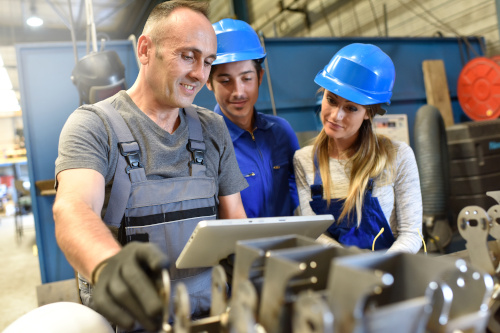The measurable success of recruiting students into STEM based pathways via a popular high school program known as FlexFactor has led the Department of Defense to recently invest $5 million via its Manufacturing Engineering Education Program (MEEP). This investment will adapt and export the FlexFactor framework to be used nationally by eight Manufacturing USA Innovation Institutes and nonprofit partners focused on emerging technologies.
Developed in San Jose, Calif. by the Flexible Hybrid Electronics Innovation Institute known as NextFlex, FlexFactor is the hallmark of NextFlex’s workforce development portfolio. An awareness building program designed for middle school and high school students, FlexFactor puts students in the shoes of business leaders facing real world opportunities and challenges that flexible hybrid electronics help to solve.
Via an immersive six-week program, students gain a deeper understanding of the advanced manufacturing sector as well as the tools, skills, and judgment required for effective decision making as it relates to developing and bringing a new technology product to market.
“FlexFactor guides student teams to explore emerging technologies and entrepreneurial thinking through an inquiry-based approach where they examine the lifecycle of a product. The process begins with a specific problem’s identification, then progressing to a potential technological solution including a traditional business case, that vets an opportunity based on projected demand, distribution partnerships and a forecasted return on investment for a given solution,” said Courtney Power, Workforce Development Portfolio Manager at NextFlex.
“Students not only explore the technological aspects of a potential product, but the projected sales and operational costs associated with bringing that product to market. In doing so, they hone 21st century skills like critical thinking and collaboration, all while getting a taste of what a career in advanced manufacturing might look like for them.”
Working under the leadership of NextFlex, each of the participating MEEP-granted innovation institutes (America Makes, ARM, BioFab USA, IACMI, MxD, NIIMBL, and Rapid) adapted the turn-key program to highlight their own technology focus area and showcase their industry participants. The first institute to launch the adapted curriculum was BioFab, who launched their program known as BioTrek, in New Hampshire during the Spring of 2021. BioTrek has grown rapidly, starting from four classrooms in one high school, to five high schools reaching over 500 students in less than a year. Collectively, NextFlex and the seven other institutes will see the model be active in 42 geographic markets across 20 states by year-end 2022.
“Biofabrication is a field that’s rapidly growing, and there are lots of interdisciplinary partnerships, particularly in the medical space. It’s a field with a lot of range,” explains ARMI | BioFabUSA’s Education and Workforce Development Program Coordinator Matt Long. “NextFlex was crucial in helping us pivot this program to biofab-specific content and making it work for us. The main difference in our program is an emphasis on science as we incorporate lessons on biology to establish the foundation for biofab. By doing this, BioTrek can provide students with a uniquely deep understanding of the industry.”
Clearly, the strength of the FlexFactor model lies in its ability to effectively engage high school students at the right moment in time–prior to making life decisions about education and career pathways–with the right people from industry and nearby community colleges who can provide students with the resources, opportunities, and access to mentors who will help to guide their decision-making up to and through college. Doing so exposes students, often from under-served communities, with the opportunity to visualize themselves joining an industry that they otherwise might have never imagined joining. Importantly, 2021 national surveying bears out this type of student impact, with 87 percent of participating students being more aware of the range of career opportunities in STEM and Advanced Manufacturing.
One of the program’s most successful partnerships has been in Elyria, Ohio with Lorain County Community College (LCCC). LCCC was early to adopt FlexFactor and has embraced the program to reach an ever-expanding audience of students from middle school through high school.
Starting with a pilot of 13 students during the 2017-2018 school year, Lorain County Community College has now impacted over 1,800 students through the FlexFactor program. In the last two years alone, the Lorain County Community College FlexFactor ecosystem has grown by 47 percent, increasing and deepening partnerships with government and nonprofit organizations, school districts, and industry partners alike.
Commenting on the local impact of FlexFactor, Dr. Marcia Ballinger, president of Lorain County Community College said, “We saw early on the potential that FlexFactor had to encourage innovation while sparking an interest in STEP and advanced manufacturing among our next generation workforce. It gives local students the opportunity to connect with industry leaders in their own backyard, seeding career connections they might not have considered otherwise and instilling a kind of confidence that only comes from deeply engaging in projects and solving problems that are important to them.”
The national expansion of FlexFactor, which as of year-end 2021 has already reached more than 8,500 students nationally and is projected to exceed 11,000 students by 2025, will accelerate its reach even further through the MEEP grant partnership with the other Manufacturing Innovation Institutes. Clearly, what started as a pilot program with eight students at Lincoln High School in San Jose, California in 2016, has blossomed into a national standard of excellence for STEM based learning.
- 3 ways to avoid summer learning loss - April 19, 2024
- High school students say AI will change the workforce - April 18, 2024
- Motivating students using the Self-Determination Theory - April 17, 2024


